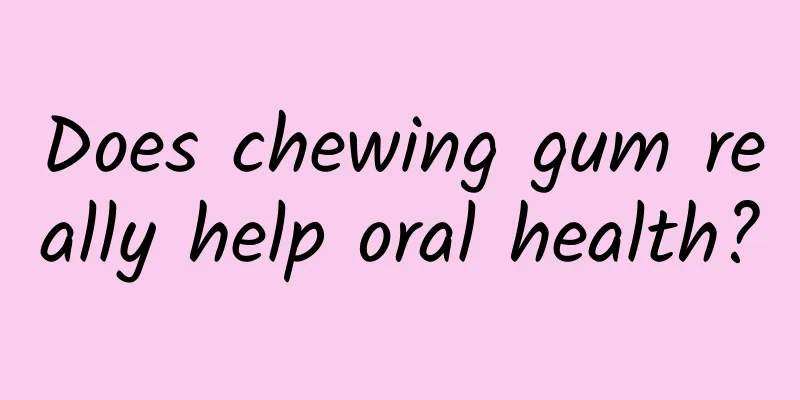Does chewing gum really help oral health?

|
Although such advertisements are rare today, there is no doubt that chewing gum advertisements once occupied a considerable share in people's vision. I don't know when chewing gum became the focus of public attention, and I don't know when it faded from the public's vision. The only thing left is an unresolved question in the eyes of many people - what role does chewing gum play in people's oral health. When I was a child, I seemed to have heard the elders say that "chewing gum too much will cause tooth decay", and this statement is so inconsistent with the overwhelming chewing gum advertisements that promote chewing gum to clean teeth. Today, let's take a closer look at what chewing gum is from a scientific perspective. Chewing gum is a candy made by mixing and pressing natural gum or thermoplastic resin as the colloid, with sugar powder, starch, syrup and spices added in.[1] This definition of chewing gum, which was handed down from the last century, is still in use today. It can be seen that chewing gum is mainly composed of two parts: the colloid that constitutes the main structure and various sweeteners and seasonings that constitute the flavor. So, does chewing gum really contain sugar? The answer is - yes, but only in the past. The picture below is a picture of chewing gum craftsmanship from the last century. From the picture, you can see that "sugar" and "coloring" seem to include everything that the elders are afraid of. No wonder many elders often tell us that chewing gum is an unhealthy food - well, maybe it is not a food. Figure 1 A chewing gum production process from the last century [1] Before we move on to our next discussion, let's take a look at why sugar is a major detriment to oral health. Sugars left in the mouth, such as sucrose, maltose, and glucose, can be used as nutrients for the reproduction of oral microorganisms - or germs if you like. At the same time, microorganisms can also use them as raw materials to synthesize many different types of organic acids, making the inside of the mouth an acidic environment, which may cause the tooth enamel to be slowly corroded, eventually leading to tooth decay. Of all sugars, sucrose is dubbed the “culprit of dental caries” because sucrose, and only sucrose, can be used by microorganisms to synthesize soluble or insoluble extracellular polymers, which promote the formation of dental plaque and help microorganisms better adhere to teeth, allowing them to produce organic acids on teeth more comfortably and longer. If the sucrose residue in the mouth is not cleaned up in time, the probability of people, especially children whose teeth are not yet fully developed, suffering from dental caries will be greatly increased [2]. Now we can talk about chewing gum. At present, the basic ingredients of chewing gum have not changed much. The only difference is that chewing gum no longer uses sugar to produce sweetness, but uses xylitol as the main sweetener. However, just this one change has greatly changed the status of chewing gum in oral health. Let's talk about the main sweetener in chewing gum: xylitol. First, it hardly participates in the nutritional metabolism of the human body or microorganisms, that is, it will not be converted by microorganisms into various organic acids that are harmful to the oral cavity, nor will it cause obesity. In addition, scientific experiments have proven that xylitol can directly inhibit the reproduction and attachment of Streptococcus mutans, the main species of harmful oral bacteria, while inhibiting the clustering of microorganisms and the formation of dental plaque [3]. Finally, it should be noted that xylitol, as well as most sugar substitutes, are basically not a threat to dental health or physical health. The American Academy of Pediatric Dentistry (AAPD) has even recommended the use of xylitol chewing gum to prevent dental caries in children [4], because the chewing action allows xylitol to work better in the mouth. Figure 2 (molecular structure) Xylitol. Xylitol can produce sweetness because its structure is similar to sugar and can interact with sweet taste buds. Perhaps many people are very resistant to the term "sugar substitute", believing that it is not "natural" and is very much an "industrial additive". In fact, such resistance is unnecessary. At present, sugar substitutes have been widely used in food production, the development process of natural sugar substitute products is also constantly advancing, and the country has made clear regulations on the dosage of various sugar substitutes [5]. In fact, most sugar substitutes are relatively stable in nature, do not participate in the metabolic cycle in the human body, and can be considered harmless to the human body. In addition, the xylitol mentioned above is mainly obtained through deep processing of crops such as corn cobs and sugarcane bagasse, and has nothing to do with the so-called "technology and hard work". The topic of whether chewing gum can promote dental health has actually been discussed for a long time[6]. Adding alkaline drugs to the gum base can effectively prevent the formation of an acidic environment in the mouth; adding caries-preventing agents can also directly prevent the formation of caries; adding abrasives to chewing gum can make teeth clean and bright. Currently, there are many new forms of chewing gum, and many innovative attempts have been made in the production of chewing gum, such as incorporating some traditional Chinese medicine or health products, and researching chewing gum with the function of removing bad breath[7]. Figure 3 A new type of modern chewing gum process, the steps are obviously much more complicated [8] Therefore, as long as the production meets national standards and there is no false advertising and commercial fraud, chewing gum can be a protector of people's oral health. However, when buying chewing gum, we should also pay attention to the specific ingredients of the chewing gum to determine whether it is the type we want; in addition, in terms of oral hygiene, chewing gum cannot replace brushing because it cannot clean the dead corners between teeth. Today, chewing gum no longer seems to be a thing that is in the center of the public's vision. In the past, we would wait by the TV for the commercials between TV series, we would use the change we got back to buy some snacks next to the cashier after checking out at the supermarket, and we would quarrel over some trivial matters in terms of food health. We often encountered chewing gum in these occasions - now, these, along with the popularity of chewing gum, have become a thing of the past. The progress of science and technology is not only about the appearance of many new and novel technological products around us, but also brings many changes in people's lifestyles. These changes will create a series of chain reactions and get results that seem to be very bizarre at first glance. The reason why I wrote this ending is because I was inspired by the news that "the popularity of smart phones has led to a decrease in chewing gum sales" that I heard before - people look at their phones more when checking out at the cashier, resulting in not paying attention to the chewing gum next to the cashier. Strange, but reasonable. The development of science and technology is like this, one move affects the whole body, and just moving forward normally can see countless unexpected scenery or anecdotes. Perhaps there is even more knowledge contained in chewing gum, too much to count. References: [1] Song Yan. Chewing gum production technology[J]. Grain Processing, 1992(03):36-37. [2] Gupta, Megha Sugar Substitutes: Mechanism, Availability, Current Use and Safety Concerns-An Update. Maced. J. Medical Sci.2018;6(10):1888-1894 [3] Trahan L, Bareil M, Gauthier L. Transport and phosphorylation of xylitol by a fructose phosphotransferase system in Streptococcus mutans. Caries Res. 1985; 19:53-63. [4] American Academy of Pediatric Dentistry: Policy on the use of Xylitol. Reference manual. 2014-15; 37(6):45-47. [5] Lu Wanyao, Zhao Yun, Zhang Sicong, Wang Jian, Zhao Shuna. Analysis of the game between sugar and sugar substitutes and development trends[J]. Sugarcane Sugar Industry, 2021, 50(03): 80-93+3. [6] Peng Dexin. Chewing gum for preventing dental caries[J]. Stomatology, 1985(02):82. [7] Zhou Hongyuan, Li Hujun, Zhang Jinwei, Hou Dajun. Research status of functional chewing gum for removing bad breath[J]. Food and Fermentation Technology, 2010, 46(02):19-22. [8] Yu Peili, Xu Jinwei, Zhou Xiaohong, Zhang Xinghai. Research on the formulation and process of yellow tea gum-free gum[J]. Modern Agricultural Science and Technology, 2018(13):248-250. |
<<: The secret of surgical safety: fasting and no drinking, do you really understand its importance?
>>: Your kidneys are not good, maybe you drink too much sugary drinks
Recommend
How to warm the uterus and dispel cold
We often hear that it is not good for women to ha...
How to partition a small apartment beautifully? Decoration skills for small apartment partitions
We all know that many houses have different layou...
What should girls do if they have heavy arm hair?
Girls should have very little body hair, which is...
Can I drink honey water during my period?
For a woman, the most painful moment in her life ...
In addition to drinking milk, these 9 ways to supplement calcium are cheap and effective! The sixth one you definitely didn't expect...
Calcium plays a vital role in the formation of hu...
What is the cause of strong echo in the endometrium?
For those who are diagnosed with strong echoes in...
Which sanitary napkin is best?
There are many brands of sanitary napkins, and it...
What should I do if I take two folic acid tablets a day?
Folic acid is one of the vitamins needed by the h...
How many weeks of pregnancy should I do an electrocardiogram
After a woman becomes pregnant, she should do dif...
What causes nipple pain during pregnancy
Women's breasts play a huge role immediately ...
Why does a pregnant woman have stomach pain when sleeping?
Stomach pain can have a devastating impact on peo...
Girls' calf circumference
Modern women pursue health and beauty. Every fema...
[Tribute to Scientists] How is AIDS detected?
As we all know, AIDS is a major infectious diseas...
Why do women usually have pain on both sides of their lower abdomen?
If a woman has pain on both sides of her lower ab...
How much does private hair removal cost?
Women's pubic hair has always been a problem ...









